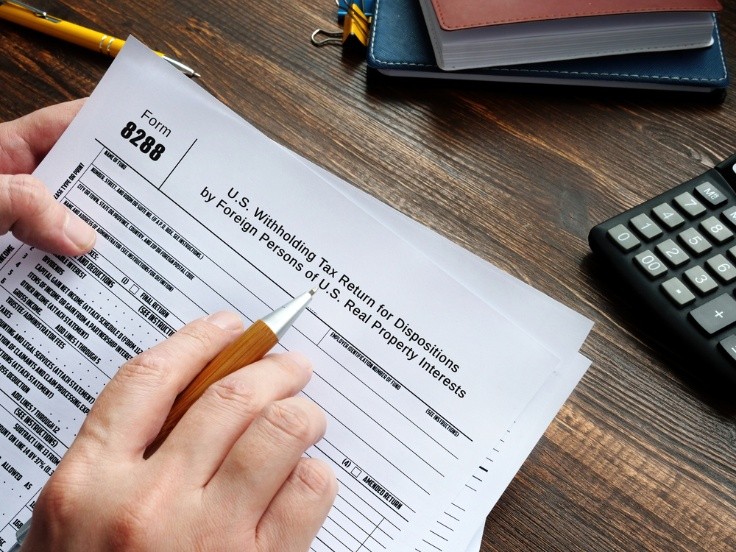-
U.S. Office Address: 2319 S.W. 29 Ave., Miami, Fl. 33145
U.S.Mailing Address: 2520, Coral Way, Suite 2014, Miami, FL 33145
U.S. Number: 754-368-2330

Foreign individuals buying or selling property in the U.S. are subject to a set of tax rules that often go unnoticed—until it’s too late. One of the key documents in this process is IRS Form 8288. Whether you’re a buyer, seller, or closing agent, this form is more than just paperwork; it’s the official document that helps the IRS collect taxes from foreign sellers under the Foreign Investment in Real Property Tax Act (FIRPTA).
If you’re not sure how Form 8288 works, what it involves, or how to use it correctly, don’t worry. This detailed guide will walk you through the essentials and the lesser-known insights that can help you stay compliant, avoid penalties, and possibly even reduce withholding amounts.
IRS Form 8288, formally known as the U.S. Withholding Tax Return for Dispositions by Foreign Persons of U.S. Real Property Interests, is used to report and submit taxes withheld from foreign sellers involved in U.S. property transactions.
Under FIRPTA, the buyer is required to withhold 15% of the gross sales price and remit it to the IRS on behalf of the foreign seller. This withholding is treated as a prepayment of the foreign seller’s potential tax liability.
So essentially, this form isn’t just documentation—it’s a financial transfer that the IRS uses to ensure compliance from non-U.S. persons disposing of real estate in America.
Most people assume the foreign seller is responsible for FIRPTA forms. But surprisingly, the burden typically falls on the buyer (or their agent). That’s right—if you’re buying property from a non-resident alien or foreign corporation, the IRS expects you to withhold and report that 15%.
Failing to file correctly can result in the buyer being held personally liable for the unpaid tax. Yes, that’s a huge risk!
IRS Form 8288 was created specifically to enforce FIRPTA, a tax law passed in 1980 that prevents foreign individuals from avoiding U.S. tax obligations when selling U.S. real estate.
Without FIRPTA, there would be no guarantee that a foreign seller pays taxes on gains from U.S. property sales. That’s why FIRPTA—and by extension, Form 8288—exists: to make sure the IRS gets its share before the money ever leaves the country.
The clock starts ticking the moment the transaction is complete.
Missing the deadline can result in penalties, interest, and additional IRS scrutiny—not something you want to deal with during or after closing.
Filling out IRS Form 8288 isn’t overly complicated, but it does require accurate information. Here’s a quick breakdown:
Once completed, the form and withholding payment must be sent to the IRS. The IRS will process it and later send the seller a stamped copy of 8288-A, which they’ll need to file a U.S. tax return and claim any refund due.
Each of these errors could delay the process—or worse, cause financial and legal penalties. That’s why working with a professional team that knows FIRPTA inside and out is crucial.
Yes—and this is where things get really interesting.
Foreign sellers can request a reduction or elimination of the 15% withholding if they believe their actual tax liability will be less. This is done by filing Form 8288-B—a separate application for a withholding certificate.
But here’s the catch: the buyer cannot skip the 15% withholding unless Form 8288-B has been filed and approved before closing.
Timing matters. If you plan to use this option, you must start early—ideally weeks or months before the closing date.
IRS Form 8288 may seem like just another government form, but for buyers and sellers involved in international real estate deals, it’s a financial gatekeeper. Properly handling Form 8288 ensures compliance with FIRPTA, prevents costly mistakes, and can open doors to tax-saving opportunities.
Don’t risk penalties or delays. Whether you’re a buyer, agent, or foreign seller, it pays—literally—to get it right the first time.
At Firpta Tax Returns, we make FIRPTA compliance easy. From completing IRS Form 8288 to applying for reduced withholding with Form 8288-B, our expert team takes care of the paperwork so you can focus on closing the deal.
Contact us today for a smooth, hassle-free experience with FIRPTA filings.